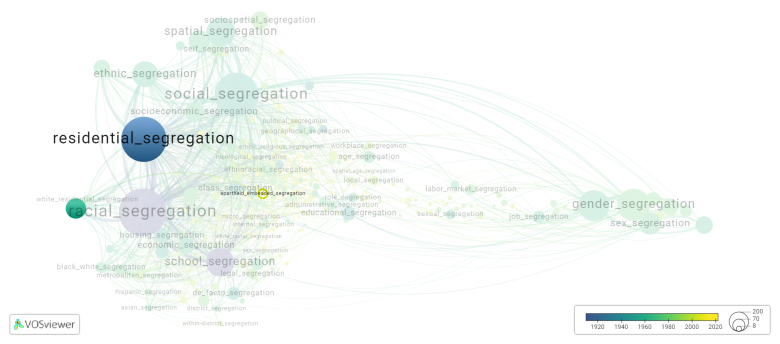Apartheid embedded segregation: Difference between revisions
(Creating page) |
(Creating page) |
||
| Line 31: | Line 31: | ||
[[File:apartheid_embedded_segregation.png|780x780px]] | [[File:apartheid_embedded_segregation.png|780x780px]] | ||
This visualization is based on the study [[How_to_cite_Segregation_Wiki| The Multidisciplinary Landscape of Segregation Research]]. | |||
For the complete network of | For the complete network of interrelated segregation forms, please refer to: | ||
* | * [https://tinyurl.com/2235lkhw First year of publication] | ||
* | * [https://tinyurl.com/2d8wg5n3 Louvain clusters] | ||
* | * [https://tinyurl.com/223udk5r Betweenness centrality] | ||
* | * [https://tinyurl.com/244d8unz Disciplines in which segregation forms first emerged (Scopus database).] | ||
==References== | ==References== | ||
==Notes== | ==Notes== | ||
Revision as of 07:48, 10 October 2024
Date and country of first publication[1]
2015
South Africa
Definition
Apartheid embedded segregation refers to the entrenched and institutionalized system of racial segregation that characterized South Africa during the apartheid era (1948-1994). This system was designed to systematically discriminate against non-white South Africans, particularly Black Africans, Coloreds, and Indians, by segregating them from the white minority population in all aspects of life, including residential areas, schools, healthcare facilities, and public spaces.
Key features of apartheid embedded segregation included:
Legislation: The apartheid government enacted a series of laws known as the "pass laws" that restricted the movement of non-white South Africans and dictated where they could live, work, and travel. These laws enforced the physical separation of different racial groups and allocated resources unequally along racial lines.
Residential Segregation: The Group Areas Act of 1950 assigned specific residential areas to different racial groups, effectively creating separate neighborhoods and townships for whites, Blacks, Coloreds, and Indians. Non-white residents were forcibly removed from areas designated for whites and relocated to racially segregated townships far from urban centers.
Infrastructure and Services: The apartheid government systematically underinvested in infrastructure and public services in non-white areas, leading to poor living conditions, inadequate healthcare, and substandard education facilities for non-white communities. Meanwhile, white areas enjoyed better amenities and higher-quality services.
Social and Economic Inequality: Apartheid embedded segregation entrenched social and economic disparities between racial groups, with white South Africans enjoying privileged access to education, employment opportunities, and economic resources, while non-white South Africans faced systemic discrimination and limited socioeconomic mobility.
Although apartheid officially ended with the democratic elections of 1994 and the establishment of a non-racial democratic government under President Nelson Mandela, the legacy of apartheid embedded segregation continues to affect South African society today. Efforts to address the persistent inequalities and disparities resulting from apartheid remain ongoing through policies aimed at promoting reconciliation, social justice, and economic empowerment for previously disadvantaged communities.
See also
Related segregation forms
Apartheid embedded segregation is frequently discussed in the literature with the following segregation forms:
residential segregation, racial residential segregation

This visualization is based on the study The Multidisciplinary Landscape of Segregation Research.
For the complete network of interrelated segregation forms, please refer to:
References
Notes
- ↑ Date and country of first publication as informed by the Scopus database (December 2023).
At its current state, this definition has been generated by a Large Language Model (LLM) so far without review by an independent researcher or a member of the curating team of segregation experts that keep the Segregation Wiki online. While we strive for accuracy, we cannot guarantee its reliability, completeness and timeliness. Please use this content with caution and verify information as needed. Also, feel free to improve on the definition as you see fit, including the use of references and other informational resources. We value your input in enhancing the quality and accuracy of the definitions of segregation forms collectively offered in the Segregation Wiki ©.
Apartheid embedded segregation appears in the following literature
Hamann C., Horn A.C. (2015). Continuity or Discontinuity? Evaluating the Changing Socio Spatial Structure of the City of Tshwane, South Africa. Urban Forum, 26(1), 39-57. Kluwer Academic Publishers.https://doi.org/10.1007/s12132-014-9231-7
